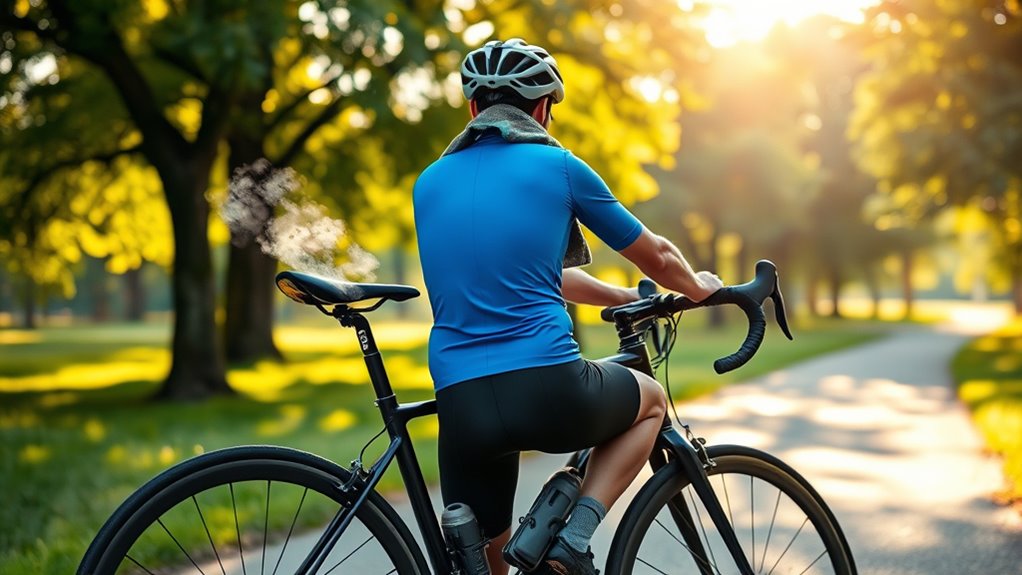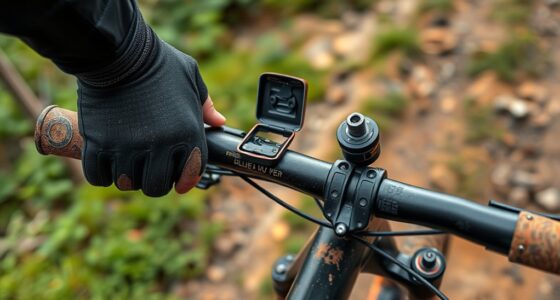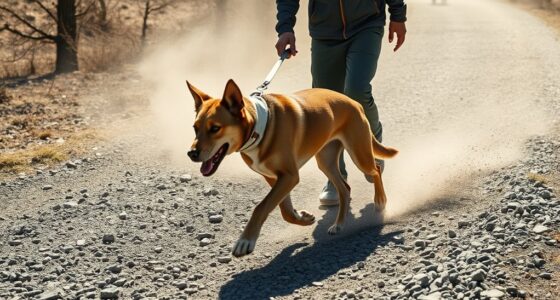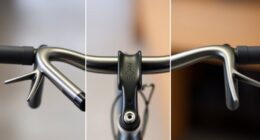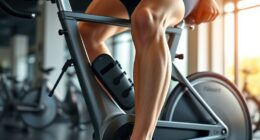After your ride, focus on a gradual cool-down that includes light cycling or stretching to help your muscles relax. Rehydrate with water or electrolyte drinks to replenish lost fluids and minerals, which supports recovery and reduces cramps. Stretch major muscle groups while warm and incorporate foam rolling to release knots and improve blood flow. Creating a calm, well-ventilated environment helps your muscles recover faster and prepares you for your next ride. For more tips, keep exploring effective recovery strategies.
Key Takeaways
- Replenish lost fluids immediately with water or electrolyte drinks to support hydration and muscle function.
- Incorporate stretching of major muscles used during riding, holding each for 20-30 seconds to improve flexibility.
- Use foam rollers or massage tools post-ride to release muscle knots and enhance blood flow.
- Create a recovery environment with good ventilation, a calm space, and proper temperature to promote relaxation.
- Follow a mindful cool-down routine combining hydration and stretching to reduce soreness and prepare for future rides.
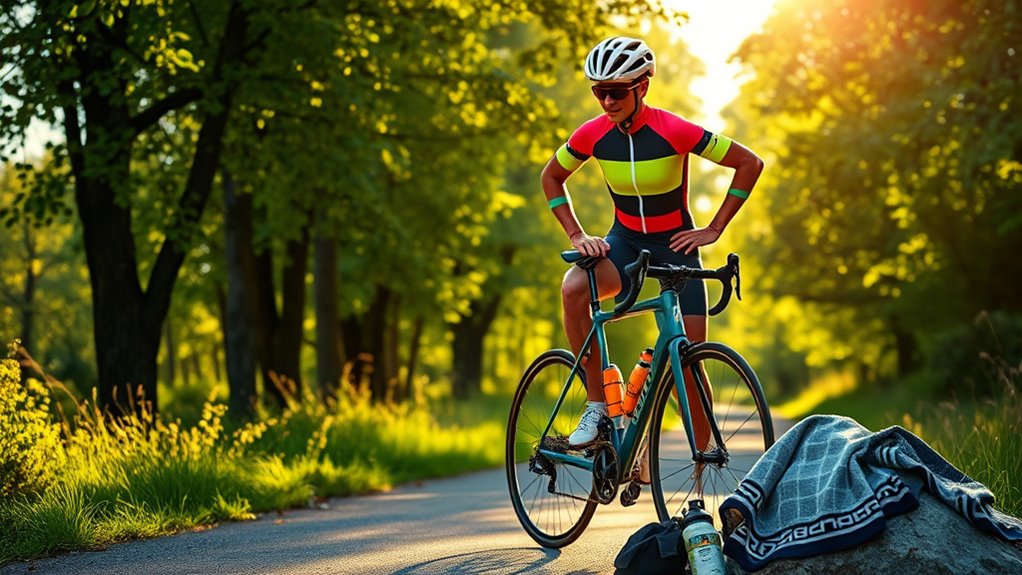
After pushing your body hard, replenishing lost fluids is crucial. Drink water or electrolyte-rich beverages to restore your hydration levels and replace minerals like sodium and potassium lost through sweat. Staying hydrated supports muscle function, reduces cramping, and speeds up recovery. It’s best to start sipping fluids immediately after your ride and continue over the next few hours. Don’t wait until you’re thirsty—regular intake guarantees your body stays properly hydrated. Incorporating proper ventilation considerations into your recovery space can also help regulate temperature and promote better air quality, enhancing your overall recovery experience.
Alongside hydration, incorporating stretching routines into your cool-down is vital. Stretching helps relax tense muscles, improve flexibility, and reduce stiffness. Focus on the major muscle groups used during your ride, such as your quadriceps, hamstrings, calves, hips, and lower back. Hold each stretch gently for about 20 to 30 seconds, avoiding bouncing or forcing your body into uncomfortable positions. Stretching while your muscles are warm allows for better elongation and can prevent tightness from lingering. It’s a good idea to include both static stretches and light dynamic movements, depending on how intense your ride was. Consistent stretching after rides can also improve your overall mobility and make subsequent rides more comfortable.
To maximize your recovery, combine your hydration strategies with a mindful stretching routine. Consider using foam rollers or massage tools to release muscle knots and improve blood flow. This combination helps flush out metabolic waste products like lactic acid, which can cause soreness and fatigue. After your ride, find a calm space, and take a few minutes to hydrate thoroughly before moving into your stretching routine. This sequence allows your muscles to warm up further, making stretching more effective. Remember, recovery isn’t just about immediate relief; it’s about creating habits that promote long-term muscle health and performance. Paying attention to hydration and stretching not only reduces immediate soreness but also enhances your flexibility, strength, and endurance over time.
In essence, your cool-down should be intentional and gradual. Don’t rush through it. By prioritizing hydration strategies and stretching routines, you give your body the best chance to recover quickly and safely. This mindful approach ensures you’re ready for your next adventure on the bike, feeling stronger and more prepared each time.
Frequently Asked Questions
How Long Should a Cool-Down Last After Cycling?
A cool-down should last about 5 to 10 minutes after cycling. During this time, gradually reduce your intensity to help your heart rate return to normal. Incorporate post-ride stretching to improve flexibility and prevent muscle tightness. Focus on major muscle groups like your hamstrings, quads, and calves. Remember, a proper cool-down duration helps your body recover efficiently and reduces soreness, making your next ride more comfortable.
What Are the Best Stretches for Post-Ride Recovery?
Think of your post-ride recovery as unwinding a tightly wound spring. You should focus on stretching routines that target your hamstrings, calves, quads, and hip flexors, holding each stretch for about 20-30 seconds. Incorporate foam roller exercises to release muscle tension and improve blood flow. These routines help reduce soreness and prevent injury, ensuring you’re ready for your next ride with less discomfort and more flexibility.
Should I Hydrate Immediately After My Ride?
Yes, you should hydrate immediately after your ride. Proper hydration timing helps replenish lost fluids and maintain electrolyte balance, which is essential for recovery. Drinking water or an electrolyte-rich beverage within 30 minutes of finishing ensures your body rehydrates efficiently. This quick action supports muscle repair, reduces soreness, and gets you ready for your next ride. Don’t wait too long—your body needs those fluids right away.
Is It Necessary to Do Active Recovery on Rest Days?
Yes, doing active recovery on rest days can be beneficial. Rest day benefits include reducing muscle stiffness and promoting circulation. You can incorporate active recovery methods like light cycling, walking, or gentle stretching to help your body recover faster without overexerting. This approach keeps your muscles engaged, improves flexibility, and supports overall recovery, ensuring you’re ready for your next ride or workout.
When Should I Consider Professional Recovery Treatments?
You should consider professional recovery treatments like sports massage or ice baths when you notice persistent soreness, fatigue, or signs of overtraining. These treatments help reduce muscle tension and inflammation, speeding up recovery. If your muscles feel tight or you’re experiencing lingering aches, schedule a sports massage or try an ice bath. Regular use can improve your overall performance and prevent injury, especially during intense training periods.
Conclusion
Now that you’ve learned the essentials of cool-down and recovery, imagine what could happen if you skip these steps. Will your muscles tighten up, or will you release faster, more effective gains? The choice is yours—your body’s future depends on it. Don’t underestimate the power of proper recovery. Stay committed, stay curious, and see what your body can achieve when you give it the care it deserves. The next ride could be your best yet—are you ready?
